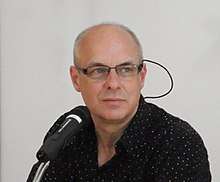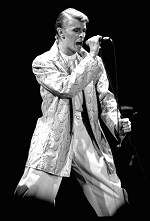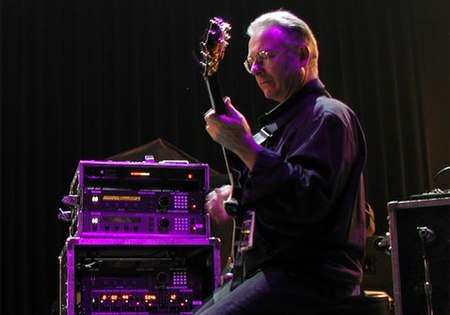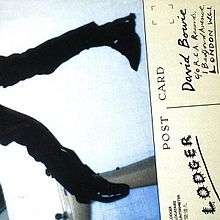Berlin Trilogy
The Berlin Trilogy consists of three consecutively released studio albums by English singer and songwriter David Bowie: Low (1977), "Heroes" (1977) and Lodger (1979). The albums were recorded after Bowie took up residence in West Berlin in late 1976, and saw him experiment with elements of electronic, krautrock, ambient, and world music in collaboration with American producer Tony Visconti and English musician Brian Eno.
Bowie began referring to the three albums as a Berlin-centered trilogy during the promotion of Lodger, although "Heroes" was the only installment primarily recorded in the city. Each album reached the UK top five. Bowie would later call the music of the trilogy his "DNA".[1] Consequence of Sound characterized the trilogy as an "art rock trifecta",[2] and Rolling Stone wrote that the Berlin Trilogy "stands as some of the most innovative music in the artist's influential canon".[3]
Background
Following Bowie's Thin White Duke period and the commercial success of the singles "Fame" and "Golden Years" in 1976, he was eager to escape the drug culture of Los Angeles,[4] where he had developed a cocaine addiction.[5] He had also become embroiled in controversy regarding comments he made seemingly in favour of fascism.[6] He blamed his erratic behaviour on his addictions and precarious mental state,[7] saying "I was out of my mind, totally crazed."[8] He called the period "the darkest days of my life" and confessed to having no memory of the recording of Station to Station in Los Angeles in late 1975 due to his "astronomic" cocaine addiction.[9] As his health deteriorated, Bowie attempted to reduce his cocaine intake and phase out the Thin White Duke persona, whom he had come to see as "a nasty character indeed."[5] He said: "It was a dangerous period for me. I was at the end of my tether physically and emotionally and had serious doubts about my sanity."[10]
Bowie moved to Switzerland in the second half of 1976. There, he began exploring other art forms and visiting galleries in Geneva and the Brücke Museum in Berlin, becoming (in the words of biographer Christopher Sandford) "a prolific producer and collector of contemporary art ... Not only did he become a well-known patron of expressionist art, locked in Clos des Mésanges he began an intensive self-improvement course in classical music and literature, and started work on an autobiography."[11] Later that year, Bowie, along with friend and singer Iggy Pop (who had accompanied Bowie on the Station to Station Tour),[12] retreated to Berlin in a further attempt to escape his addiction and the spotlight:
For many years Berlin had appealed to me as a sort of sanctuary-like situation. It was one of the few cities where I could move around in virtual anonymity. I was going broke; it was cheap to live. For some reason, Berliners just didn't care. Well, not about an English rock singer, anyway.[13]


While sharing an apartment with Pop, Bowie became interested in the German music scene, including acts such as Tangerine Dream, Kraftwerk, Cluster, Harmonia and Neu!.[14] Before moving to the apartment on Hauptstraße, Pop and Bowie stayed with Edgar Froese of Tangerine Dream and his family at their home in Schöneberg. Froese also helped Bowie with his recovery and introduced him to the Berlin underground scene. Bowie named Froese's solo album Epsilon in Malaysian Pale a big influence and a soundtrack to his life in Berlin.[15][16] During the months of his recovery, he had also become interested in Brian Eno's minimalist album Discreet Music (1975). He met Eno in 1976[17][18][19] and soon after began collaborations with Eno and producer Tony Visconti.[20] In 1976, Bowie cowrote and produced Pop's solo album debut, The Idiot (1977).[21] While considered a Pop solo album, The Idiot is often referred to as the unofficial beginning of Bowie's Berlin period, though Low was recorded almost concurrently.[22] Bowie later admitted to "co-opting" the sound on The Idiot:[23]
Poor [Iggy], in a way, became a guinea pig for what I wanted to do with sound. I didn't have the material at the time, and I didn't feel like writing at all. I felt much more like laying back and getting behind someone else's work, so that album was opportune, creatively.[24]
History
1976–77: Low
The album Low (1977) was recorded as Bowie grappled with difficult personal issues, including a troubled marriage and drug dependence: "There's oodles of pain in the Low album. That was my first attempt to kick cocaine, so that was an awful lot of pain. And I moved to Berlin to do it. I moved out of the coke centre of the world [i.e., Los Angeles] into the smack centre of the world. Thankfully, I didn't have a feeling for smack, so it wasn't a threat".[26] Visconti contended that the title was partly a reference to Bowie's "low" moods during the album's writing and recording.[27] The album marked a movement for Bowie into electronic[28] and ambient music.[29] Side one of the album contained short, direct avant-pop song-fragments;[30] side two comprised longer, mostly instrumental tracks.[30] Often incorrectly given credit as Low's producer,[31] Eno was responsible for a good deal of the direction and composition of the second side of the album and wrote the theme and instrumentation for "Warszawa" while Bowie was in Paris attending court hearings against his former manager.[32] Partly influenced by the Krautrock sound of Tangerine Dream, Kraftwerk and Neu!, Low evinced a move away from narration in Bowie's songwriting to a more abstract musical form in which lyrics were sporadic and optional.[19][33] [16]
Low and The Idiot were mostly recorded in France, and of Bowie's trilogy only Low and "Heroes" were recorded at Hansa Studios in Berlin, nicknamed "Hansa by the Wall" for its proximity to the imposing structure that divided West from East Berlin.[4] Although he completed the album in November 1976, it took his unsettled record company another three months to release it.[34] It received considerable negative criticism upon its release—a release which RCA, anxious to maintain the established commercial momentum, did not welcome, and which Bowie's ex-manager, Tony Defries, who still maintained a significant financial interest in the singer's affairs, tried to prevent. Despite these forebodings, Low yielded the UK number three single "Sound and Vision", and its own performance surpassed that of Station to Station in the UK chart, where it reached number two.
1977–78: "Heroes" and world tour

Echoing Low's minimalist, instrumental approach, the second of the trilogy, "Heroes" (1977), incorporated pop and rock to a greater extent, seeing Bowie joined by frequent Eno collaborator and King Crimson guitarist Robert Fripp. Like Low, "Heroes" evinced the zeitgeist of the Cold War, symbolised by the divided city of Berlin.[35] Incorporating ambient sounds from a variety of sources including white noise generators, synthesisers and koto, the album was another hit, reaching number three in the UK. Its title track, though only reaching number 24 in the UK singles chart, gained lasting popularity, and within months had been released in both German and French.[36] Referencing the burgeoning new wave music scene, RCA Records marketed "Heroes" with the slogan "There's Old Wave. There's New Wave. And there's David Bowie ..."[19]
After releasing "Heroes" in 1977, Bowie spent much of 1978 on the Isolar II world tour, bringing the music of the first two Berlin Trilogy albums to almost a million people during 70 concerts in 12 countries. By now he had broken his drug addiction; biographer David Buckley writes that Isolar II was "Bowie's first tour for five years in which he had probably not anaesthetised himself with copious quantities of cocaine before taking the stage. ... Without the oblivion that drugs had brought, he was now in a healthy enough mental condition to want to make friends."[37] Recordings from the tour made up the live album Stage, released the same year.[38]
1979: Lodger


It was around the time of Lodger (1979) that Bowie began framing his previous two albums as the beginning of a Berlin-centered trilogy concluding with Lodger, largely as a marketing technique to support the unusual new album.[39] Lodger, the final piece in what Bowie called his "triptych", eschewed the minimalist, ambient nature of the other two, making a partial return to the drum- and guitar-based rock and pop of his pre-Berlin era. Recorded in Switzerland and New York, the result was a mixture of new wave and world music, in places incorporating Hijaz non-Western scales. Some tracks were composed using Eno and Peter Schmidt's Oblique Strategies cards: "Boys Keep Swinging" entailed band members swapping instruments, "Move On" used the chords from Bowie's early composition "All the Young Dudes" played backwards, and "Red Money" took backing tracks from "Sister Midnight", a track previously composed with Iggy Pop for The Idiot.[40] The album was recorded in Switzerland. Ahead of its release, RCA's Mel Ilberman stated, "It would be fair to call it Bowie's Sergeant Pepper ... a concept album that portrays the Lodger as a homeless wanderer, shunned and victimized by life's pressures and technology."
Lodger initially received mixed reviews, and as described by biographer Christopher Sandford, "The record dashed such high hopes with dubious choices, and production that spelt the end—for fifteen years—of Bowie's partnership with Eno." Lodger reached number 4 in the UK and number 20 in the US, and yielded the UK hit singles "Boys Keep Swinging" (number 7 in the UK) and "DJ".[41][42] Towards the end of the year, Bowie and his wife Angela initiated divorce proceedings, and after months of court battles the marriage was ended in early 1980.[43] By the early 1980s, Bowie would decamp to New York City.[4]
Box-Sets
Since the trilogy's completion, several box-sets have been produced of it.
| Title | Year | Label | Albums | Notes |
|---|---|---|---|---|
| Portrait of a Star | 1982 | RCA Victor |
|
Exclusive to France, features albums listed in reverse order.[44] |
| Bowie Tech Unit | 1991 | Rykodisc |
|
US exclusive, each album features bonus tracks.[45] |
| Zeit! 77–79 | 2013 | EMI |
|
Practically the same as Bowie Tech Unit, just without the bonus tracks.[46] |
| A New Career in a New Town (1977–1982) | 2017 | Parlophone |
|
11 disc box-set containing two exclusive albums, the 2017 Mix of Lodger, and Re:Call 3[47] |
See also
- The Idiot
- Lust for Life
- Christiane F. (soundtrack compilation of songs from the Berlin Trilogy and Station to Station)
- Symphonies No. 1, No. 4 and No. 12 by Philip Glass (based on Low, "Heroes" and Lodger respectively)[48]
References
- MacLean, Rory (13 January 2016). "Bowie in Berlin: 'He drove round the car park at 70mph screaming that he wanted to end it all'". The Guardian.
- "Ranking: Every David Bowie Album From Worst to Best", Consequence of Sound, January 8, 2016
- Kreps, Daniel (11 January 2016). "Brian Eno on David Bowie: 'I Feel a Huge Gap Now'". Rolling Stone.
- Mastropolo, Frank (11 January 2016). "The History of David Bowie's Berlin Trilogy: Low, "Heroes" and Lodger". Ultimate Classic Rock.
- Wilcken, Hugo (2005). Low. New York: Continuum. p. 24. ISBN 0-8264-1684-5.
- Buckley 2005, pp. 289–91.
- Carr & Murray 1981, p. 11.
- Sandford 1997, p. 158.
- Buckley 2005, pp. 258–75.
- "Bowie's UNCUT interview on Low". BowieGoldenYears.com. Archived from the original on 2017-02-28. Retrieved 2016-03-30.
- Sandford 1997, pp. 154–55.
- Renshaw, David (January 11, 2016). "Iggy Pop: 'David Bowie's friendship was the light of my life'". NME. NME. Retrieved March 23, 2020.
- "Uncut Interviews David Bowie & Tony Visconti On Berlin". Uncut. March 2001.
- Simon Reynolds (2007). "The Final Frontier: The Analogue Synth Gods of the 1970s (interview with Edgar Froese (RIP)". Groove (in German). Retrieved 2019-02-14 – via reynoldsretro.blogspot.com (January 23, 2015).
- Hugues, Pascale (2017-01-08). "Als David Bowie bei Edgar Froese im Bayerischen Viertel wohnte". Der Tagesspiegel Online (in German). ISSN 1865-2263. Retrieved 2018-09-20.
- "Bowie's Berlin: the city that shaped a 1970s masterpiece". History Extra. Retrieved 2018-09-20.
- Seabrook, Thomas Jerome (2008). Bowie in Berlin: A New Career in a New Town. Jawbone Press. ISBN 1906002088.CS1 maint: ref=harv (link)
- "Eno: I would set up sonic scenarios for David Bowie". BBC News. Retrieved 16 June 2016.
- Carr & Murray 1981, pp. 91–92.
- Sandford 1997, p. 149.
- Needs, Kris (January 2007). "The Passenger". Mojo Classic (60 Years of Bowie): 65.
- Wilcken, Hugo (2005). Low. pp. 37–58.
- Ambrose, Joe (2004). Gimme Danger: The Story of Iggy Pop. pp. 175–178.
- Kurt Loder & David Bowie (1989). Sound + Vision: CD liner notes
- Quantick, David (June 20, 2012). "David Bowie: 1977, back from the abyss and changing music forever..." Team Rock.
- Scott Cohen. "David Bowie", Details magazine, September 1991: p. 97
- BowieGoldenYears Archived 2017-02-28 at the Wayback Machine. Retrieved 12 June 2007.
- Lukowski, Andrzej. "Album Review: Low: Live in Chicago". Drowned in Sound. Retrieved 29 March 2016.
- Mastropolo, Frank. "The History of David Bowie's Berlin Trilogy: 'Low,' 'Heroes,' and 'Lodger'". Ultimate Classic Rock. Retrieved 29 March 2016.
- "Low – David Bowie – Songs, Reviews, Credits – AllMusic". AllMusic.
- Pegg 2004, pp. 302–306.
- Hugo Wilcken (2005). Low: pp. 113–118
- Pegg 2004.
- Ruether, Tobias (Winter 2006–2007). "The Man Who Came from Hell". 032c. pp. 82–85. Retrieved 21 July 2014.
- Pegg 2004, pp. 90–92.
- Sandford 1997, pp. 181–82.
- Buckley 2005, p. 293.
- Sandford 1997, p. 189.
- Graham, Ben (January 11, 2016). "30-Years On: David Bowie's Lodger Comes In grom the Cold". The Quietus. Retrieved 6 December 2016.
- Carr & Murray 1981, pp. 102–107.
- Buckley 2005, p. 281.
- Sandford 1997, pp. 191–92.
- Sandford (1997): p. 197
- "David Bowie – Portrait Of A Star". Discogs. Retrieved 2020-05-15.
- "David Bowie – Bowie Tech Unit". Discogs. Retrieved 2020-05-15.
- "David Bowie – Zeit! 77–79". Discogs. Retrieved 2020-05-15.
- "David Bowie – A New Career In A New Town [1977–1982]". Discogs. Retrieved 2020-05-15.
- Tilden, Imogen (30 January 2018). "Philip Glass completes his David Bowie trilogy with Lodger symphony". The Guardian.
Bibliography
- Buckley, David (2005) [1999]. Strange Fascination – David Bowie: The Definitive Story. London: Virgin. ISBN 978-0-7535-1002-5.CS1 maint: ref=harv (link)
- Carr, Roy; Murray, Charles Shaar (1981). Bowie: An Illustrated Record. New York: Avon. ISBN 0-380-77966-8.CS1 maint: ref=harv (link)
- Pegg, Nicholas (2004) [2000]. The Complete David Bowie. London: Reynolds & Hearn. ISBN 1-903111-73-0.CS1 maint: ref=harv (link)
- Sandford, Christopher (1997) [1996]. Bowie: Loving the Alien. Time Warner. ISBN 0-306-80854-4.CS1 maint: ref=harv (link)
.jpg)

